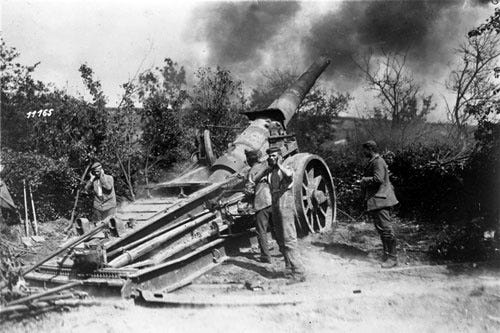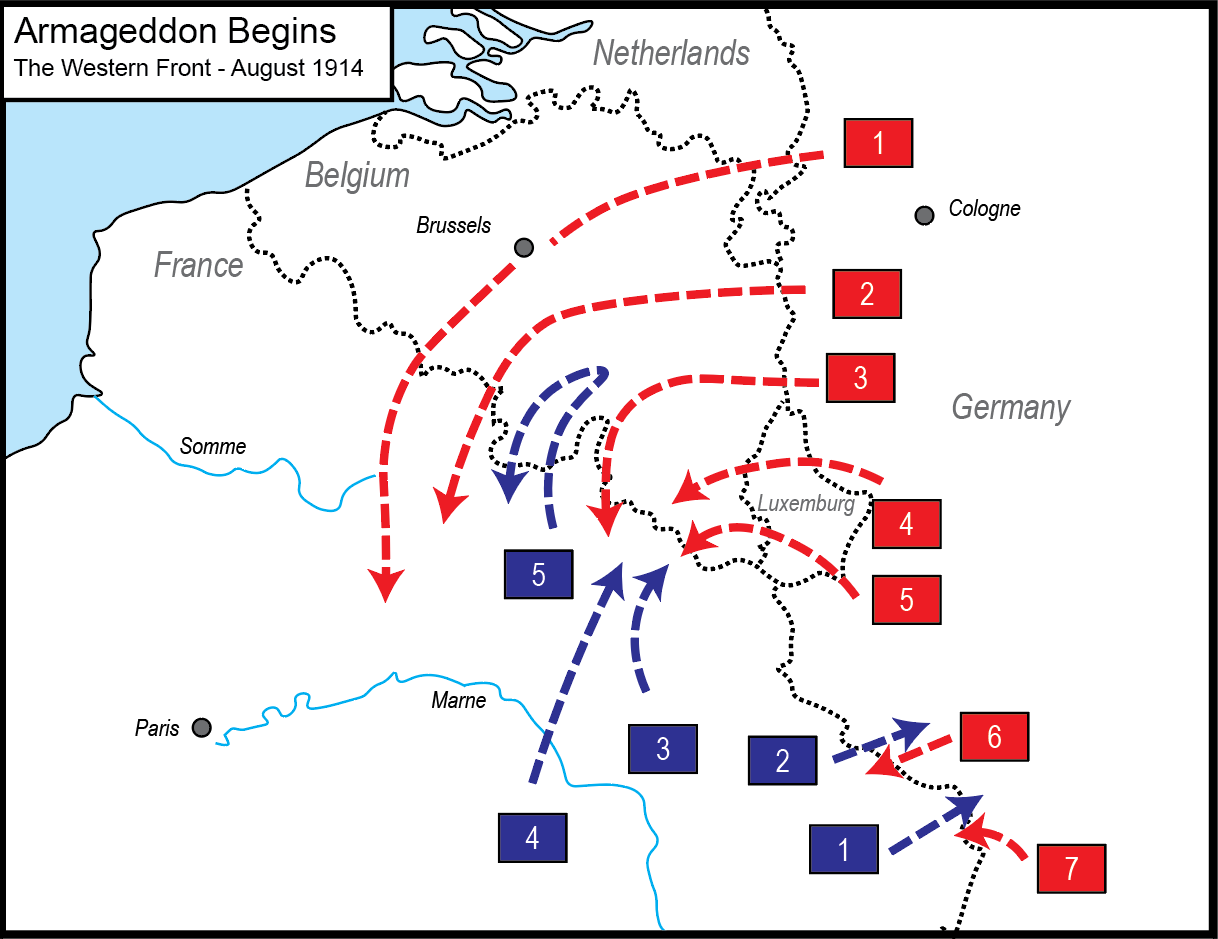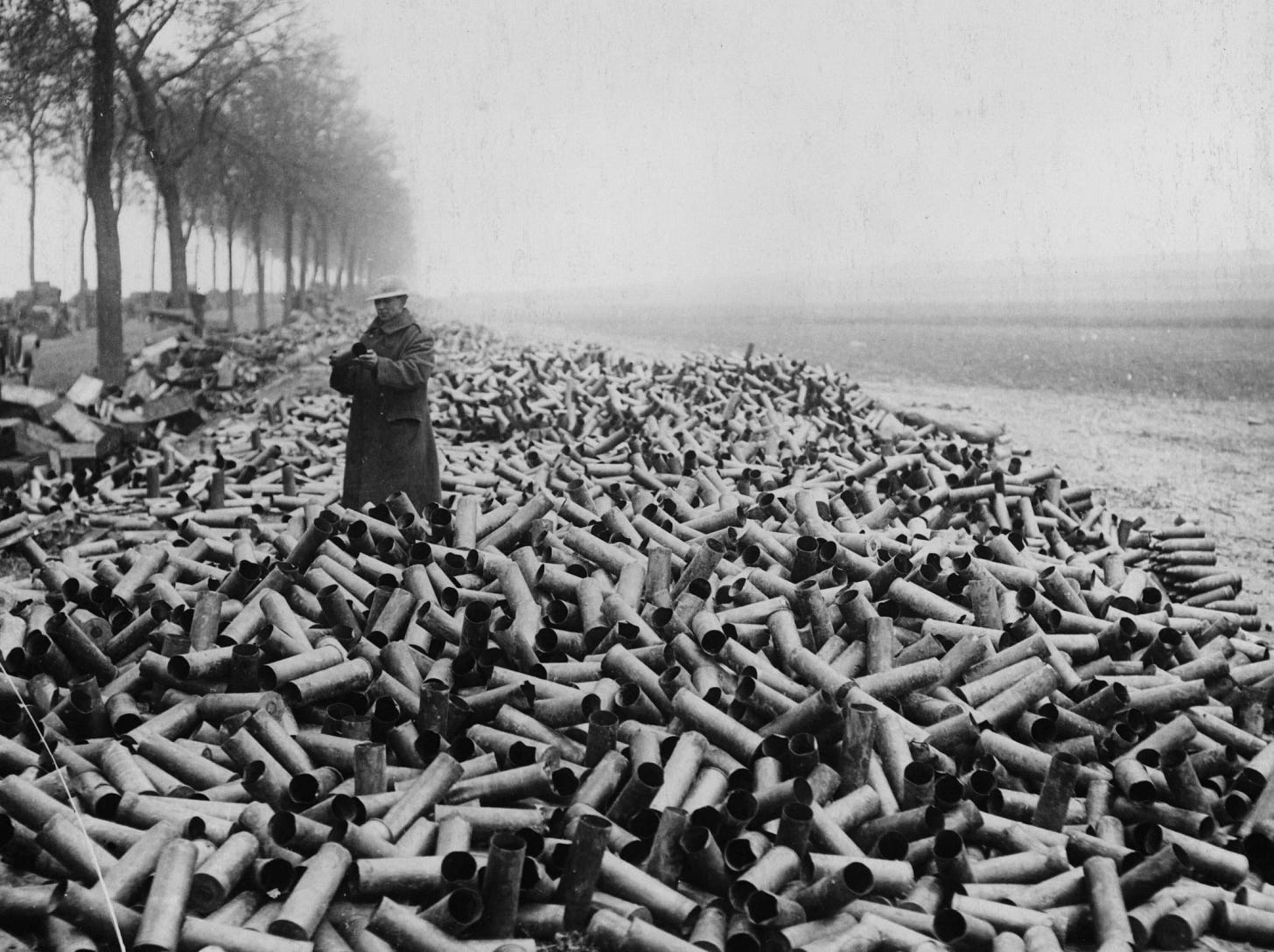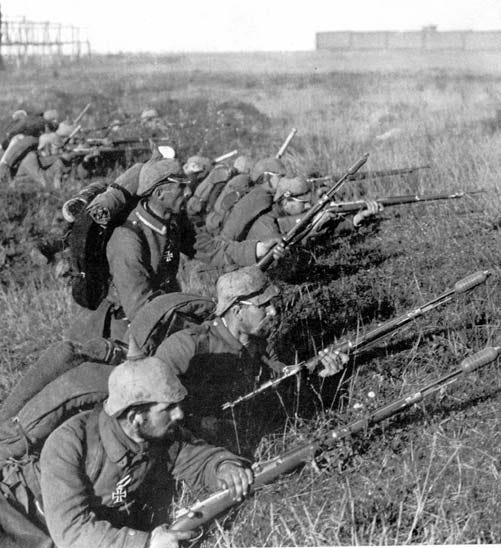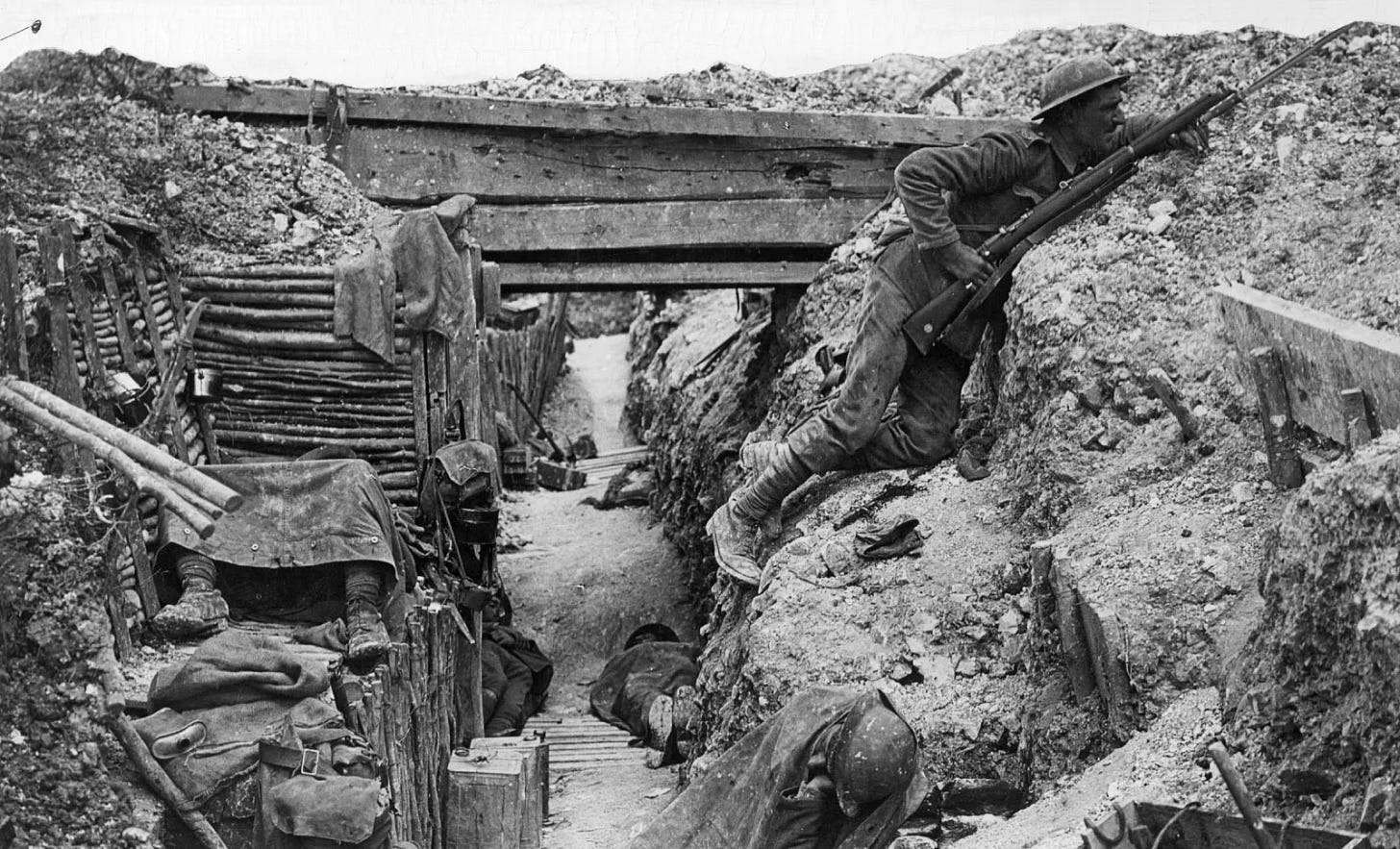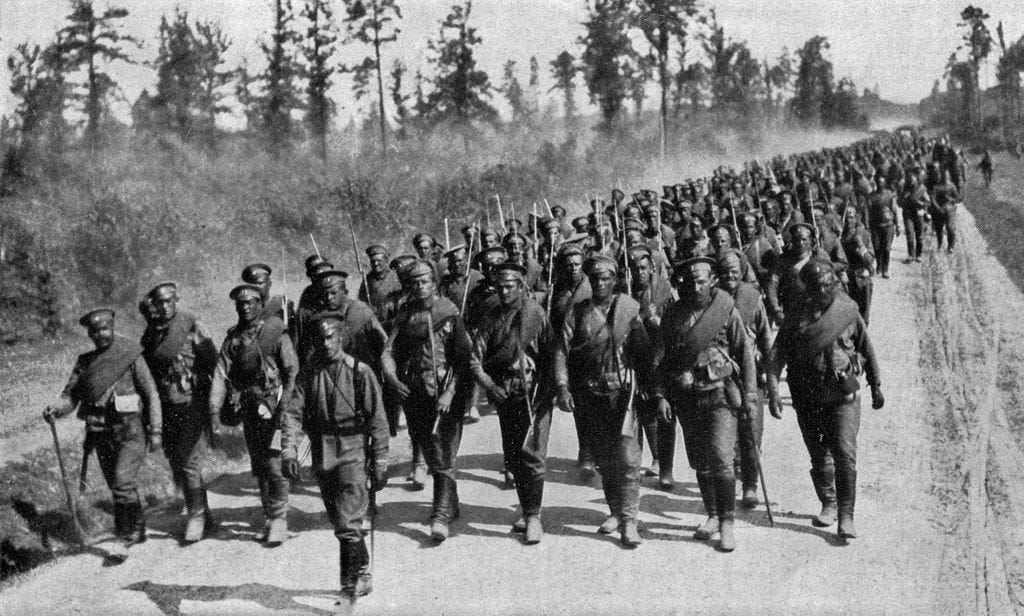Author’s Note: I apologize for the delay between articles. This particular piece took longer to publish than I had hoped due to illness and the sheer length of the piece, which is at this point nearly 8,000 words. As you will see, however, the fact that this article grew into an oversized and slow-moving creature is fitting for the subject matter.
The First World War was an unparalleled civilizational catastrophe for the peoples and powers of Europe. In the span of just over four years, nearly twenty million people would be killed, and a great deal more wounded or displaced. Over thirty million soldiers would become casualties. The war directly precipitated state collapse in four of Europe’s great powers, destroying the Ottoman, Hapsburg, German, and Russian Empires. Only two of the six European powers - Britain and France - would survive the war politically intact, but even so the conflict left them scarred with millions of dead and disabled men and crushing debt. For many, it felt as if the world was ending, and the continent was left embittered, disoriented, shocked, and angry.
From a military perspective, however, the course of the Great War was anything but an aberration. It was, in fact, the culmination and logical endpoint of a system of warfighting that had been flashing warning signs for decades. The use of stereotyped infantry formations animated by attacking elan had become progressively more costly and less decisive throughout the post-Napoleonic century. Examples were numerous, from the American Civil War, to the midcentury Crimean War (which devolved into little more than a long siege), to the carnage at Gravelotte, where the French and Prussians threw long lines of corps against each other in an artless scrum.
Soldiers in 1914 were trapped in a terrible interplay between technology, tactical orthodoxy, and operationally minded leadership. These factors conspired to make battle fundamentally indecisive and bloody - which is to say, attritional. The warrior was trapped in the belly of a horrible machine - and the machine was bleeding to death.
Failure in the West: Schlieffen and Moltke Jr
Few figures in military history have been scrutinized as closely as Count Alfred von Schlieffen - a peculiar fact, considering Schlieffen’s tenure as Chief of the German General Staff from 1891 to 1906 did not include a single actual war. To many of his contemporaries and subordinates, Schlieffen was a bona fide genius - a singular intellect whose thought gave Germany a chance at victory in the Great War. To his critics, Schlieffen was the architect of the operational scheme that doomed Germany by bringing Britain out of neutrality and into the war on the side of Germany’s enemies. Still others criticize Schlieffen as simply an old-school Prussian general who was blind to the effects that industrialized war would have on the traditional attacking style.
Much of this debate centered around a thing that did not actually exist - the so-called “Schlieffen Plan.” Supposedly, this was Germany’s secret operational scheme to win a two front war against both France and Russia. The concept, as such, was for a rapid, all out attack on France to knock her out of the war in the opening weeks - aiming to take advantage of Russia’s slower mobilization timetables by resolving the western front before Russia’s armies could arrive in the east. The crux of the alleged Schlieffen Plan was a massive sweep through Belgium, bringing the mass of the German Army down on the top of France and scooping up the French armies in a huge encirclement.
Therein lay the crux of the argument. Schlieffen’s disciples argued that the plan was operationally sound, and the failure of the 1914 campaign against France was ultimately the fault of German commanders failing to follow Schlieffen’s instructions correctly. In particular, they blame the Chief of Staff in 1914 - the great Helmut von Moltke’s nephew, Helmut von Moltke the Younger - for supposedly watering down Schlieffen’s scheme. An apocryphal story about Schlieffen muttering advice with his dying breath only helped to dramatize this version of events. For others, however, the plan was fundamentally flawed in that it required an invasion of Belgium - a neutral country under the protection of the British. By invading Belgium, critics argue, the Schlieffen Plan forced Britain into the war against Germany and created a strategic problem which simply could not be solved.
In fact, there is another version of events - the true one. The truth is that there was no Schlieffen plan at all. Schlieffen wrote a variety of memoranda concerning a war with France, many of them entirely hypothetical thought experiments. Combing through German documents would reveal no secret master plan handed down by the old general. The best one could do is find a mobilization and deployment scheme - what the Germans called an Aufmarch - a design for how to get the armies deployed on the border. The idea that Schlieffen, who retired in 1906, had somehow bequeathed a foolproof plan eight years in advance stretches credulity, and mainly originates with embittered German officers who wanted to blame Moltke Jr. for the failure of the campaign. The intense drive to blame Moltke inevitably led many to gripe that things would have been different if Schlieffen had been in charge.

So what actually happened in France in 1914? It was not the botched implementation of some secret plan for victory. Rather, it was the cumbersome, bloody, and indecisive result of two armies attempting to control the largest collision of massed infantry in history. The scale of the forces involved had ballooned to colossal proportions.
Contrary to popular perceptions, the French Army had made significant improvements in the period since the Franco-Prussian war, in particular in the department of mobilization. The French had made it a point to develop a deep pool of reservists with an intensive conscription program, to the point where in 1914 they were able to put some 2 million men in the field (though only half were engaged in the opening weeks). Germany, which had to man two fronts, was able to deploy 1.7 million to the French theater. The French had also worked hard to streamline their mobilization scheme and railway timetables, allowing them to actually complete their mobilization two days before Germany.
When war began in the first week of August, the two armies set in motion titanic operational schemes that would hurl these millions of men against each other in an unparalleled scene of violence. The schemes cohered together in a way that represented a giant revolving door. German planning called for a massed right wing to sweep down from the north through Belgium, while the French scheme - “Plan XVII” - dictated a direct thrust eastward into German Alsace-Lorraine.
The French were determine to redeem themselves of the Franco-Prussian War, where they had frittered away the campaign with inactivity. They were therefore maniacally focused on maintaining an attacking élan - mobilizing quickly and moving decisively to attack. Unfortunately, their conception of a direct eastward strike into Germany played directly into German hands. The motion of the German sweep through Belgium was to come down on the northwestern flank of the French army, creating what would be, on paper, the largest encirclement in history. By striking eastward, the French were inadvertently attacking deeper into this potential encirclement.
The French deserve credit for the improvements they made to their mobilization system. They managed to deploy five colossal field armies in the space of only a few weeks. Unfortunately - and rather bafflingly - France had done nothing to rectify the predominant tactical determinant of the past war: German artillery superiority. While the French artillery park consisted almost completely of the 75mm field gun, German units enjoyed organic batteries of 105mm, 150mm, and 210mm howitzers. This firepower disparity would prove devastating in the opening clashes of the war.
The French dutifully implemented Plan XVII, and on August 14 they sent two of their colossal field armies hurtling eastward into Germany. These attacks quickly failed with heavy losses, mostly courtesy of the powerful German artillery in Germany’s 6th and 7th Armies, which anchored the southern end of the German line. While this “battle of the frontier” did not destroy the two French armies, they did maul them sufficiently to make the French offensive collapse and force a withdrawal back into France.
Meanwhile, the great German hammer was beginning to swing down from the north. On August 16th, the German 1st and 2nd Armies - on the far right wing of the German line - invaded northeastern Belgium and began their sweep over the top. Meanwhile, German 3rd, 4th, and 5th Armies - the center of the German line - began a tighter sweep around the corner, moving through Luxemburg and southern Belgium through the forested region known as the Ardennes.
The situation for the French supreme commander, Joseph Joffre, was not exactly encouraging. His offensive into Lorraine had made it barely ten miles into Germany before it collapsed, leaving two of his field armies bloodied. Now, it was apparent that there was some sort of great German mass climbing over the top of his head. The fog of war was heavy, but even without knowing the details of the German disposition, it was clear that there was serious danger coming in from the north. Joffre still had three untouched field armies in his order of battle, and he sent two of them - the 3rd and 4th - into the Ardennes to meet the incoming Germans.
These two French field armies collided (almost literally) on August 22 with two German armies (the 4th and 5th) in the heart of the Ardennes. The French again learned a painful lesson about the power of the German howitzers, and on the 23rd they too withdrew back into France.
What to make of all this? The initial French deployment had put five field armies in the field. Four of these were now bloodied - the 1st and 2nd in Lorraine, and the 3rd and 4th in the Ardennes. These battles had gone well for the Germans - their advantage in heavy artillery left them definitively on the right side of the loss ratios, with French casualties outnumbering German losses by 2 to 1. But these were not decisive battles. All four French armies were able to break contact and withdraw intact back into France. There was no encirclement, no big war winning victories. There was no Metz or Sedan.
There was, however, one remaining intact French army - the 5th, currently probing its way into central Belgium. Here was Germany’s chance to win a big victory: to not only maul, but destroy wholesale an entire field army. The 5th Army, under General Charles Lanrezac, moved into Central Belgium and took up a position near the Belgian fortress of Namur, at the bend where the Sambre and Meuse rivers confluence. This seemed like a cozy position, with defensible lines on the rivers, and directly to the east of the British Expeditionary Force, which had now arrived in theater. Inadvertently, however, Lanrezac had wedged himself in directly between the German 2nd and 3rd Armies.
Germany now had a chance to destroy the French 5th Army - potentially taking hundreds of thousands of prisoners, and creating an opportunity to destroy the BEF in the follow up. To achieve this, the 2nd Army (facing the French across the Sambre) needed to engage and attempt to hold the French in place while the 3rd army crossed the Meuse further to the south and cut off the avenue of retreat back to France.
This opportunity slipped through German fingers. The culprit was not Moltke the Younger, nor Schlieffen, nor any single decision or commander on the German side. The blame lay at the feet of the mass army - that bloated, sluggish, clumsy monster, as capable of dishing out horrible violence as it was incapable of moving elegantly. This sector of the front was under the direction of General Karl von Bülow - in direct command of 2nd Army, but with operational control over 1st Army (on his right) and 3rd Army (on his left). This put Bülow in command of no fewer than 19 Corps, or a whopping 39 Divisions, strung out across some 70 miles of front. Controlling this colossus with any degree of precision was impossible given the communications technology of the day.
On the map, a glorious opportunity beckoned. This enormous army was simply not nimble enough to grasp it. It took nearly a full day for the Germans to get a handle on just how exposed the French were, as the battle began largely because screening units ran into each other and started firing. Moltke sent frantic orders demanding that 3rd Army get troops - any troops - across the Meuse to the south to cut off the retreat, but by this point much of 3rd Army had already begun attacking directly across the river. 3rd Army’s commander, General Hausen, had to scrape together a zombie division (comprised of various available sub-components) and send it off to the south to look for a crossing. However, on August 23rd Lanzerac realized the pickle he was in and began a withdrawal. By the time 3rd Army got units of any reasonable size across the Meuse, the French were long gone, and only an empty pocket remained.
The Namur bend was Germany’s best chance to win a decisive battle in the opening weeks of the war. It was, in fact, a very good chance - but the difficulties of controlling the mass army made waste of it, and so the French 5th Army, like the other four, was able to withdraw bloodied but intact. France suffered some 260,000 casualties in the battles of August (including 76,000 dead), but her armies were not destroyed, and managed to conduct the so-called “Great Retreat” to take up a new position on the Marne.
Germany’s failure to destroy at least one of the French field armies during the opening weeks set up the infamous Battle of the Marne - a supposedly miraculous Allied victory which saved Paris and set up the ensuing stalemate of trench warfare by denying the Germans a decisive victory.
But what was the Battle of the Marne, from an operational perspective? The preview had been clearly seen 44 years prior, at Gravelotte - parallel lines had simply hammered each other all day until one army had had enough. The Marne was Gravelotte on a continental scale. Where Gravelotte had lined up exactly five Prussian corps against five French corps, the Marne pitted parallel lines of seven field armies each. Germany alone brought some 44 corps to the Marne. Whereas Gravelotte had been fought on a front that was at most 15 miles wide, the Marne campaign stretched the contact practically from the Swiss border to Paris - a frontage of more than 200 miles.
There exists a traditional narrative as to why Germany lost at the Marne. Generally, analysis points to General von Kluck (in command of First Army, on the far right of the German line) turning right as he approached Paris. The goal of the campaign was to crush the French Army, not to capture Paris (the French government having evacuated anyway), and so “Kluck’s Wheel” was designed to bring him into contact with French forces. By turning, however, he exposed his own right flank to attack from freshly mobilized French forces. This, in combination with stiff French resistance and counterattacking elsewhere along the line, was enough to make Moltke nervous, and he ordered a withdrawal to form a new defensive line farther north.
The general notion here is that Germany still had a decent chance to win at the Marne, but the French did just enough to spook Moltke into pulling back. Generally, therefore, the outcome of the battle is chalked up to a combination of French resilience and Moltke’s apparent caution and lack of fortitude.
I argue that it was once again the nature of the armies that was to blame. German 1st and 2nd Armies - those crucial and powerful formations on the right wing - spent the battle mostly out of contact with each other. Their commanders, Kluck and Bulow, did not communicate either with each other or with Moltke, who had established his headquarters a whopping 150 miles away in Luxemburg. During the crucial days of the battle (from September 5 to 9) Supreme Headquarters neither issued a single order nor received a report from 1st and 2nd Armies. In the end, Moltke had to send a subordinate officer to visit the various field commanders, with instructions as to what orders he should give based on what he learned at the front. Needless to say, this was simply an inadequate method for successfully controlling such an enormous force. Meanwhile, most German artillery units were beginning to run short of ammunition, and commanders continued to fight in a vacuum without a clear sense of what was happening in their neighbor units.
Ultimately, this was a footsore army fighting hundreds of miles from home on an enormous front, which had left its railheads and telegraph stations behind weeks ago. It was simply beyond the capabilities of the time to effectively supply and control such an enormous force at such enormous distances. The body of the army had outgrown the nervous system.
Perhaps Schlieffen had been clairvoyant after all. In 1901, the old general had written the following:
According to current theory, modern means of communication have made the command of million-man armies as easy and sure as an earlier corps of 15,000 to 20,000 men. While this may be true in one’s own land, the telegraph will not suffice in enemy territory; it has already proven itself unreliable in maneuvers. Wet weather and difficult roads stop the cyclist; automobiles are subject to endless difficulties... It is to be hoped that improvements in these areas will make the distribution of orders easier and simpler. At present, however, the armies consist of masses that are ever more difficult to control and ever less maneuverable.
It seems that this, and not some secret operational plan, was the true wisdom that he had left behind, and in 1914 Moltke found it every bit as difficult to manage his enormous armies as Schlieffen had predicted. Germany had brought a steamroller to the battlefield. Steamrollers are very good at crushing things and very bad at turning.
This, moreso than any miraculous French stand at the Marne or deficient generalship by Moltke bears most of the blame for Germany’s failure to achieve a rapid victory in 1914. To be sure, Moltke the Younger left much to be desired and did not live up to the name of his famous uncle, but the larger issue was that he simply lacked the mechanisms to control the army effectively, even if he had been a more capable general. Both at the Namur bend and at the Marne, the Germans simply could not get their operations level units (divisions and corps) to move as quickly as they wanted.
By the time the Germans withdrew from the Marne on September 12, both sides had taken some 250,000 casualties just since the beginning of the month. German withdrawal precipitated the transition to the trench warfare that became the stereotype of the war, as both sides began an intensive effort to dig in and consolidate a defensive line.
It must be emphasized, however, that trench warfare did not cause the failure of maneuver. Rather, the causality was reversed: the failure of maneuver led to trenches. Having failed to win a rapid victory in 1914, trenches were dug to consolidate positions and preserve manpower. Despite multiple attempts to restart proactive offensive warfare, no viable solution would be found in the west until 1918.
Meanwhile, in the east, the German army was fighting a very different sort of war.
Mobile War in the East
The two German fronts in 1914 could hardly have been more different from each other. Indeed, in many ways they were almost complete opposites. In the west, Moltke struggled to coordinate and maneuver a colossal force of seven field armies, operating on enemy terrain without adequate supply, communications, or intelligence. In the east, in contrast, a single field army was tasked with defending the backdoor into Germany against a potential invasion from a vastly superior Russian force - albeit with the benefit of the German rail lines and communications infrastructure. Thus, while the enormous western armies lumbered about, in the east the Germans were able - and indeed, forced - to fight a mobile war.
From the outset, the Eastern Front promised to be a lively place. German prewar assumptions were frustrated from the outset, when the Russians managed to significantly overperform expectations on their mobilization timeframe (while Germany’s ally, Austria-Hungary, performed poorly). German planning had optimistically assumed that Russia, with its vast internal distances and low population density, would require multiple weeks before it could put armies in the field. It was hoped, therefore, that Germany might be blessed with a short time of quiet in the east while it finished off France.
Russia, however, defied such expectations by putting two armies into the field in East Prussia by August 17, roughly simultaneous with the first week of clashes on the western front. These two Russian armies - the 1st, under General Paul von Rennenkampf and the 2nd under General Alexander Samsonov, hardly represented the full scope of Russia’s mobilization powers (at least four other armies being committed against Austria-Hungary), but they had 27 full divisions between them, and given the fact that only a single German army with 11 divisions was in the theater to stop them, they had the potential to affect a decisive blow at the opening whistle of the war.
Their objective was a pincer movement into East Prussia. One of the idiosyncrasies of the eastern front in 1914 was the fact that, due to the peculiarities of the winding borders, all the combatants began with the war with a major salient - that is, a position vulnerable to invasion from at least two directions. At the center of this was Russia’s Polish holdings, which jutted out in between Germany and Austria Hungary. The Polish Salient was both a glaring vulnerability (in that the Central Powers could invade it from three directions), but it also offered an advance position deep in the German belly.
The Russian operational notion was straightforward and conceptually sound. 1st Army would advance directly westward into East Prussia on an axis from Vilnius, while 2nd Army would move to the northwest out of Poland. The German 8th Army (numbers 1 through 7 being in France) would be caught in between two enormous slabs of iron, inexorably pressing it towards the sea.
There was nothing fundamentally wrong with the Russian plan. This was a fairly straightforward, even textbook pincer movement, maneuvering two armies towards each other to catch the enemy in the middle. Several factors, however, conspired in Germany’s favor. The two Russian armies would be separated by the Masurian lakes - a morass of more than 2,000 small lakes, impassable to the modern mass army. This meant that the two Russian bodies would be unable to support each other until they had bypassed the lakes, leaving them operationally isolated for the first sixty miles of advance. Secondly, the Russians suffered from inadequate communications and reconnaissance - making no real use of surveillance aircraft (despite having them in the inventory) and little use of cavalry screens. Meanwhile, Samsonov and Rennenkampf communicated with unencrypted radio transmissions which the Germans were able to intercept and decipher.
Perhaps the most important factor, however, was the decision by German high command to remove the commander of 8th Army, General Maximilian von Prittwitz. Prittwitz was an unimaginative officer who saw that he was sitting in the crosshairs of two giant Russian pincers, and promptly wired Moltke at headquarters for permission to retreat from East Prussia altogether. Giving up German home territory without a fight in the first month of the war was, for understandable reasons, unappealing to Moltke, and on August 22 Prittwitz was removed from command and replaced by General Paul von Hindenburg, who arrived in East Prussia the following day with his chief of staff, Erich Ludendorff.
Keep reading with a 7-day free trial
Subscribe to Big Serge Thought to keep reading this post and get 7 days of free access to the full post archives.






